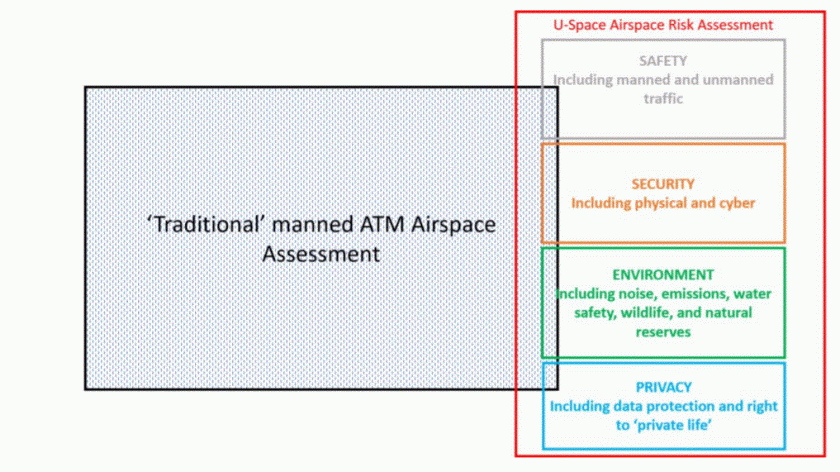The European Union Aviation Safety Agency (EASA) has published its proposal for Acceptable Means Compliance and Guidance Material (AMC & GM) to enable harmonised implementation of U-space airspaces and U-space services as well as certification of U-space service providers across the European airspace.
According to EASA:
“The publication of NPA 2021-14 follows the adoption of the U-space regulatory package, which creates the conditions necessary for both drones and manned aircraft to operate safely in the U-space airspace. The development of AMC & GM is crucial as the U-space regulations only provide a high-level framework for the U-space to enable the first operations of UAS without specifying the necessary means on how to enable harmonised implementation of the U-space.
Public comments on the NPA need to be submitted by 15.03.2022.
The document proposes a number of clarifications in key areas:
Target level of safety (TLS)
“…it is considered premature to propose, at this stage of the U-space regulatory implementation, a quantitative analysis based on assumptions for which there is still uncertainty for the U-space environment. In the future, when more operational experience has been gained in the implementation of U-space, numerical examples to propose a TLS will be provided with the needed accuracy.”
Common information system (CIS)
“Member States may decide to designate a dedicated entity to provide the CIS on an exclusive basis in a given U-space airspace. Such ‘single CIS provider’ would make available the relevant information to all relevant operational stakeholders. The single CIS provider would need to be certified for the services it provides. The designation of a single CIS provider would need to be notified to other Member States as well as to the Agency. (d) In the absence of a single CIS provider, the common information is directly exchanged between the relevant operational stakeholders in a distributed, peer-to-peer communication architecture, whereby each data provider communicates with another USSP directly for sharing information. Each USSP needs to communicate with other data providers. A clear allocation of common information elements between Member States, ATS providers and USSPs would allow data users to find target data quickly and efficiently. In the absence of a single CIS provider, there is no need for an additional certification; the provision of common information elements by ATS providers and USSPs will be covered by their respective certificate and provisions of Regulation (EU) 2021/664 and amendment to Regulation (EU) 2017/373.”
CIS use of standards
“In the context of a distributed CIS model, Member States can elect to use ASTM WK63418 ‘New Specification for Service provided under UAS Traffic Management (UTM)’ to provide some or all the relevant dynamic restrictions. The standard specifies how competent authorities may then use CIS providers (certified as USSPs) to disseminate the dynamic restrictions that they are authorised to issue….”
Information shared between the U-space service provider (USSP) and air traffic service (ATS) provider
“The possible scope of data and information shared between the USSP and the ATS provider may be: (a) dynamic airspace reconfiguration procedures and responsibilities including pre-planned and ad hoc manned operations; (b) traffic information other than that provided through CIS (ATS.OR.127); (c) aeronautical information other than that provided through CIS; and (d) other data needed by the USSP and available to the ATS provider.
Multiple USSP operations in the same airspace
“U-space services can be provided concurrently by multiple USSPs in the same airspace. This requires information exchange and coordination amongst those USSPs, as well as between USSPs and other entities (such as UAS operators, ATS providers and CIS providers). This information exchange is expected to be based on open protocols and formats, using public, IPbased networks as transport layers.”
Network identification services
“USSPs can use a common contract (master agreement) defining the technical indicators associated with the provision of the network identification service, acceptable and unacceptable service levels, parameters for data-sharing between the providers, as well as dispute resolution procedures and actions to be taken in specific circumstances.”
The contract between the USSP and the ATS provider
“A contract between the USSP and the ATS provider should cover at least these three objectives: (1) provide clear reference to service ownership, accountability, roles and/or responsibilities. (2) present a clear, concise, and measurable description of provision of services; and (3) match the expected service provision with actual service support and delivery.”
Further analysis and commentary to the document will be made available to Unmanned Airspace readers over the coming weeks.
For more information
(Image: EASA)




